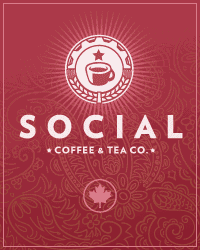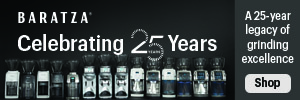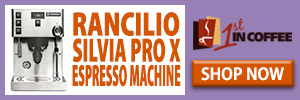In the previous State of Coffee article, I talked about Ken Davids, his Coffee Review website and the August feature on espresso – or more specifically, an Italy vs. America Showdown on Espresso. And I was pretty harsh on Ken, a guy I consider one of my “sensei” in the world of coffee. It wasn’t pretty, it wasn’t pleasant, and I took absolutely no pleasure in what I wrote.
A lot has happened since the publication of that article. Discussions about how espresso should be evaluated and ranked was a particularly hot topic. Tasting a wide range of espresso blends, including those from Italy, the United States and Canada happened with an eye towards doing a transparent and fair evaluation, with no sacred rules kept intact – everything was open, and everything was on the table. I also wrote a two part article called “Battle Royale – Italy vs. North America” detailing much of that evaluation and the results. Both articles were supposed to be published on CoffeeGeek, and I was just about to post Part One when I heard from Ken Davids himself.
Ken was upset about my previous article and asked if he could get equal time on CoffeeGeek to respond to what he perceived as an attack on his reputation, testing methodology and scoring of the coffees in that August review. I was more than happy to offer the opportunity to publish the rebuttal because if nothing else, I felt it was ultimately fair to Ken to do so. I also hoped it would foster debate and discussion in something that there really is no set standard on right now – how to fairly evaluate, rate, and rank espresso.
Because I had these two completed but unpublished articles, I gave Ken advance copies of them so he could read all the theories, discussions, and criteria that a bunch of people, myself included, came up with on evaluating espresso in a more transparent and fair fashion. Armed with this information, Ken wrote a second draft of his rebuttal (having already submitted his first), but for reasons it’s best not to speculate on, just before I was set to publish his article, he decided to revoke the article intended for CoffeeGeek, and instead sent out a slightly revised version (which actually was very complimentary towards me and this website) in an email newsletter, and later posted it to Coffee Review, here.
I am glad that Ken’s rebuttal is now out there in public – and especially glad that he gives more detail into his espresso testing and evaluation efforts. What I’m not so happy with is that he chose a largely “one way” method to share this information. It’s not published on a community website that’s open to everyones’ participation. It’s not really out there in the public eye where people can debate, discuss, and evolve the procedures. It went out in email, which encourages private conversation, and it was published on Coffee Review, a website that doesn’t have user-comments enabled. If you want to comment, you have to do it via email, on your own blog, or on a third party community-oriented coffee website, which in a sense fractures any developing conversations.
That in itself is a shame, and really contrary to what the Internet has done for coffee, espresso, and everyone involved in culinary coffee and espresso – including Ken Davids. The ability for you, the reader, to actually interact and be part of the information sharing and discussion process is one of the reasons why I think we’ve seen so much advancement in the quality of coffee and espresso in the last decade. The Internet allows this… but only if the one initiating the conversation allows for public discussion to continue.
This is all a preface, and a brand new one at that. Now that Ken has gotten his rebuttal out there, and added more clarity to his espresso evaluation methods, much of what I wrote for this article is now moot. But much is still relevant, so with this preamble out of the way, I’d like to get into the meat of this first of two articles that will talk about evaluating espresso as we put well-regarded Italian blends up against well regarded North American blends.
Coffee Evaluation and the Points System
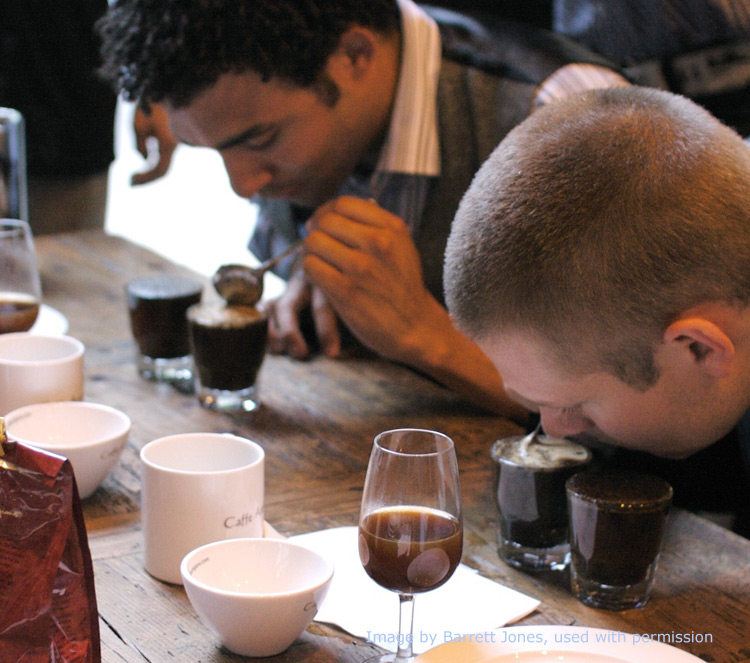
I already talked at length about the initial interpretations I had, and some fellow Vancouverites had regarding Coffee Review’s August look at espresso, so I don’t want to continue rambling on that subject too much. Suffice to say, many of my friends and colleagues in this industry had a difficult time accepting that five Italian blends, all with months-old coffee (as well as and one mass-market US blend) could top the blend from one of America’s best known culinary coffee roasters. Even worse was accepting that three of these stale blends could score 90 points or higher.
Putting aside any kind of judgement on where the coffees placed for a moment, I’d like to bring up something particular – the idea of a 90+ point coffee. If you’re new to the world of quality coffee, or the intricacies of cupping and evaluating coffee, consider this a short primer.
The coffee cupping method has been around for decades now – dating back to the 1800s and possibly much longer. But it wasn’t until the 70s and 80s that you started to see a move towards standardizing the cupping methodology for evaluating coffee, and this is one of Ted Lingle’s lasting contributions to the world of coffee. Lingle, one of the founders of the SCAA, and it’s long-serving Executive Director (retired last year), is one of the chief champions of the cupping form, cupping methodology, and cupping “taster’s wheel” that the vast majority of roasters and coffee evaluators use today. Of course many others have helped to develop these things, and still others have helped to evolve it (including butting heads with Lingle about changes to the form… the rather famous debate between George Howell and Lingle over the Cup of Excellence’s cupping evaluation methodologies and forms come to mind), but the bottom line is, a lot of the standards and practises in cupping coffees comes from the pioneering work Lingle has done.
Cupping is a regimen that, to provide “equal ground” across all the samples, is done the same way – all the coffees being evaluated are roasted to the same level; the sample size ground is identical; the amount of water used is identical in all ways (temperature and volume)’; the steep time is identical; and the evaluation processes (aroma, steep, crust break, slurp, evaluation of the beverage from hot to warm to cool) is identical across all the samples.
In addition, there’s some rules, both written and unwritten, about cupping coffees. One that always bothered me was on the individual 10 point scores handed out for things like body, acidity, aroma, etc, nothing is scored below a “5”. The reasoning is, if it scores below a 5, it shouldn’t be on the table. (in some scoring sheets, all the points are on a 1-5 point basis, with 50 points “added” at the end of the scoring).
Before I digress too much, my point about this is that cupping is regimented, and that regimen, very strict and even across the table, has served the coffee (not espresso blend) evaluation world quite well for decades now.
Yesterday’s 85…
Now on the points. When I first got into coffee (which wasn’t so long ago), anything that scored in the 80s was considered a fantastic sample of coffee, a “must try”. If you happened to get something that scored an 88 or 89, that one you had to go out of your way to get. In the early part of this century, we started to see coffees creep more and more into the 90 point range – not much higher, but 90s, 90.5s, even the super rare 91s. As the Cup of Excellence took off, we started to see better and better quality coffees, and cupping results hitting the amazing lofty heights of the 92s and 93 scores.
But in the last few years, and especially as Coffee Review started to really become popular, all of a sudden, a score of 89 or 90 started to lose meaning. Now we’re seeing, not only from Ken, but from cupping competitions like the Best of Panama, coffees scoring in the 95 points or higher range. 96s and even 97s are handed out at Coffee Review. It’s gotten so that, I know of one roaster who recently submitted coffee to Coffee Review, scored a 91, and was disappointed by that score. Now my question is, has perspective in coffee evaluation been lost, or are coffees just getting that much better?
I’ll leave the former supposition to your imagination, and address the latter. Yes, coffees are getting better – and I would agree that 1995’s 85 point coffee would probably score a 75 or 70 today. But everything’s relative – this would mean that today’s 90 point coffee (considered “low” in the world of Coffee Review) would get probably 110, or 115 points in 1995 – but it wouldn’t have. It would have probably gotten 90 points back then. Because while I believe the quality skew is constantly moving upwards in the world of coffee, I also believe the expectations you have from the cup should equally skew upwards. That we’re seeing scores in the mid 90s now, and roasters disappointed if they get a 91 or an 89 means there’s problems in the way coffee is evaluated.
And these problems really come to the forefront for me when I see three coffee blends, all from Italy, all blends that have travelled by sea for a month, sat in warehouses for another month, and sat on store shelves for a month or two, scoring between 90 and 93 points, as they did on Coffee Review. Is this the result of a skewed tasting platform? Ken’s been accused in the past of rewarding his advertisers with high scores, but this is certainly not the case here – none of the coffees he evaluated were (at the time of publication) from his advertisers.
The honest thought is this – should any espresso blend even score a 90 today, much less a 93? And how was the scoring done? Is it rigid? Is it based on cupping scoresheets? Is anything below a “5” not allowed on the scoresheet? Was the barista pulling those shots really that good? All valid questions, I think.
I asked Andrew Barnett (of Ecco Caffe) what the best shots of espresso he ever had were, and he rattled off a list of fond memories. At the top of his list was the shot pulled for him in the finals of the 2006 WBC, by Klaus Thompsen, the eventual winner. I asked Andrew, a seasoned and highly regarded coffee cupper in his own right, what score he would give that espresso shot. Very quickly, Andrew answered:
“I’d give it a 91 or 92 – it was just superlative.”
One of the world’s top cuppers, and a guy considered one of the top sensory judges in the WBC, gave the world’s best barista a 91 or a 92 on their WBC-winning espresso shot. And that espresso shot scores lower than two of the months-old Italian blends on Coffee Review’s August feature. It kinda puts things into perspective, doesn’t it?
If a 90 (or 91 or 92) is reserved for the best of the best, then where should other blends be scoring when a competent (but not WBC winning) barista is pulling the shots. 70s? 80s? 60s? What if a blend got a 79.5 and was the highest scorer in a wide range of samples: would that be a disappointment, or acknowledged for what it is?
All this talk about cupping coffees draws a conclusion that I’ve held true for some time: you cannot prepare and evaluate espresso the same way you prepare and cup coffee samples.
The Idea Behind Proper Espresso Evaluation
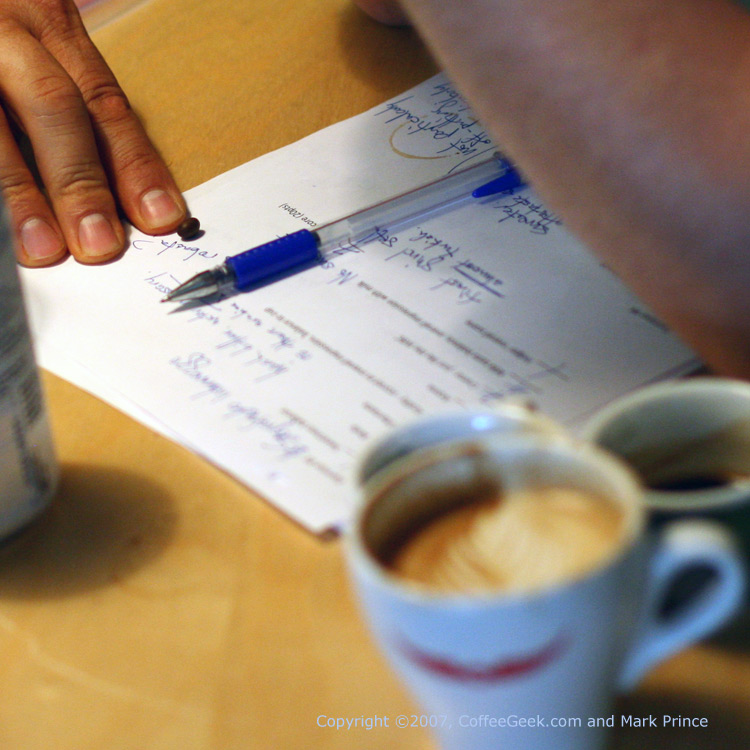
Pretty strong words – I’m saying “cannot” in the previous paragraph. I stand by it too. After reading Ken Davids’ email newsletter rebuttal (and also the articles he sent me but later asked me not to publish), I will say he isn’t following the cupping regimen as much as I initially suspected, but he is still coming from the “school of cupping”. And I can’t even fault him on that.
After all, he’s a well respected coffee cupper, and that title is well earned. He also keeps up on his reading: many of the processes listed in his espresso preparation and evaluation methodologies stem from the set of WBC rules and procedures for evaluating espresso. On the surface this may seem right way to go, especially on the preparation side of the equation. But there’s several flaws in that practise – I’d like to focus on just one of them here: Temperatures.
Baristas and their roasters usually “tune” an espresso blend for the WBC standard before competing in the WBC.
Off the shelf blends, even from the top, most culinary-coffee driven roasters, are not tuned to the WBC standard. They are tuned (in the case of high end roasters) to the best blend and roast profiles that suit those beans, or (in the case of no so high end roasters) tuned towards costs, budgets, and marketing brand names.
The most evident example is the 200F grouphead temperature standard. A few years back, a few people within the WBC sphere decided that machines used in competitions should all produce the same grouphead temperature. That’s an admirable goal; it reduces the surprises that competitors may have when they get to the competition, knowing one variable is in check and predictable. That’s a good thing.
But that same small group within the WBC also decided that the ideal grouphead temperature, or the most desirable one (both words used for lack of a better word), was 200 degrees Fahrenheit. I won’t say if that’s a good thing or a bad thing – maybe I’ll call it instead a “necessary evil”. If you have to set one temperature the same across three machines, you also have to decide what temperature that will be. 200F probably worked well for the blends that the WBC tech standards planners were familiar with, but it doesn’t mean that it works well with all blends.
A technical standard doesn’t necessarily mean “ideal standard”
And that’s where a growing problem exists. Somewhere along the way, the “200F WBC Standard” began to be interpreted as “200F is the ideal brewing temperature for espresso”. I see it in our forums. I hear it in discussions about the art and craft of the barista. I see it even at the WBC itself in some side discussions. The problem is, that statement is simply not true. It’s just a technical standard, nothing more. In fact, the WBC standard could easily be 196F at the grouphead, and probably would have been if the influencing factors involved in setting it in the first place came from different regions of the world.
Because competing baristas know the grouphead temperatures they’ll have access to, they generally work and practise at those temperatures, fine tuning their blends and espresso preparation techniques so that, at 200F at the grouphead, their blend works well. This could involve tweaking the roast, fine tuning the components, adjusting the dose, and a whole set of variables under their control.
Espresso blends made for retail sale do not go through this kind of exacting tuning. So evaluating retail consumer espresso blends at a rigid 200F temperature setting will be more fair toward the blends suited for that temperature, and disaster for those that are not tuned for that temperature. The same goes for a while wide variety of variables.
There’s several other examples of rigidity and “cupping legacy” to be found in the Coffee Review espresso evaluation methodology, and to be honest, I can’t really fault Ken on these things – it’s what he knows best – cupping. To top it all off, there really isn’t any kind of industry standard way to evaluate espresso other than the WBC’s prescribed method, and that should not be used when providing a “rating” for an espresso blend because the WBC judging forms are more geared toward evaluating the barista than they are toward evaluating the blend itself and the espresso produced.
A lot of espresso heads talk about evaluating espresso and their methodologies behind it. Talk to ten espresso-focused quality roasters about their methodologies, and you’ll get ten different answers. Talk to ten quality driven cafe owners, and you’ll get the same results. There is no real standard, a lot of hodge podge, and the fault lies with no one other than the brewing method itself. If espresso is, as George Howell said to me once, “barely out of the cradle”, espresso crafting and evaluating methodologies aren’t even out of the womb yet.
It’s time to start some serious discussion and getting that babe to pop out and start to grow.
Espresso Tasting and Testing Methodologies
Espresso is a demanding, torturous process to the coffee bean. Espresso is so demanding and exacting at times, that it can disillusion (perhaps former) fans of the process. A recent thread on Coffeed asked “How many truly perfect, wholly satisfying, and exciting espressos have you ever had?” and in some ways the resulting discussion was, to be kind, interesting. One comment in particular was site-owner Alistair Durie’s initial comment saying “espresso is overrated”… this coming from a former superfan of all things espresso.
I don’t intend for this article to debate that thread, or the implications one can read between the lines; instead, I use it as a point of reference to say that preparing and brewing good espresso is hard – damned hard. Most of the respondents in that thread talked about singular moments in their espresso tasting lives. I could equate it with how many 90+ point espresso shots have they had – the answer is few – damned few.
This is one of the core reasons why I respect espresso so much to the point of revering it as the ultimate form of expression of the coffee bean. It’s also why I have my own disdain for any kind of corner-cutting on producing the beverage, be it using single origin coffees (I’ll save my readers from another rant on this subject), or be it pods, crema enhancers, froth aiders, capsules, or super automatics.
All of these methods and elements may have their place in our culture and fast paced world because after all, not everyone has the patience or time to really “get into espresso” to the point where it just happens, and happens well. My point is, for truly great espresso, truly good techniques are a requirement. Truly good tools are a requirement. Truly good skills and knowledge are indispensable. Truly good beans, including aspects like fresh roasting, skilled blending, and proper storage are paramount to delivering a good shot. It doesn’t stop there either. Espresso’s quality is on a bit of a bell curve – you can go from horrible to acceptable pretty easily. You can go from acceptable to good fairly easily. You can go to good to great with a bit more difficulty. And you can go from great to “singular” (or the proverbial god shot) with a lot of difficulty (and many of the participants on the aforementioned Coffeed thread seem to concur with this).
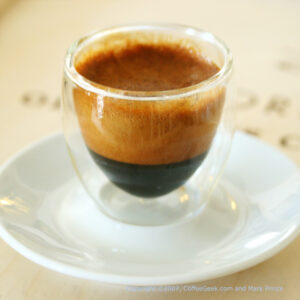
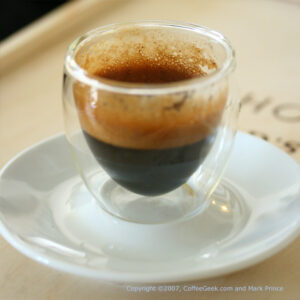

So if the goal is to evaluate a variety of espresso blends while representing all the blends equally well, being as fair to the blends as you can requires so much more than the usual way coffee is evaluated: the traditional cupping method.
Start your list with the variables. In cupping, variables are controlled and regimented. In espresso evaluation, as much leeway as possible (within reason) should be given. Tamping – I remember being at Alistair Durie’s lab with Vince Piccolo (49th Parallel Roasters) and other baristas, pulling shots of Heather Perry’s WBC Competition blend. We were doing the same dose (from an Anfim timer grinder), same machine temperature, aiming for the same brewed volume, but changing only one thing – the tamping method. Vince would try his and pull a shot. He’d vary the tamp, and pull another. Alistair would go up, not change anything except tamp in his style. And I’d do the same. And every shot came out different – different tastes, different look during the pull, different variances in the finished shot as it sat in the cup.
I could go on about variables, but I think the most important thing to establish is that even the smallest changes in variables can make or break an espresso shot. Change the grouphead temperature by 3F, and a shot that would have gotten an 85 gets a 75. Change the dose by 2 grams, stall the brew and under extract , and lose another 10 points on the scoring table. Brew the shot into a cold cup and affect the bitters or sours, and lose another 5 or 10 points.
The Barista
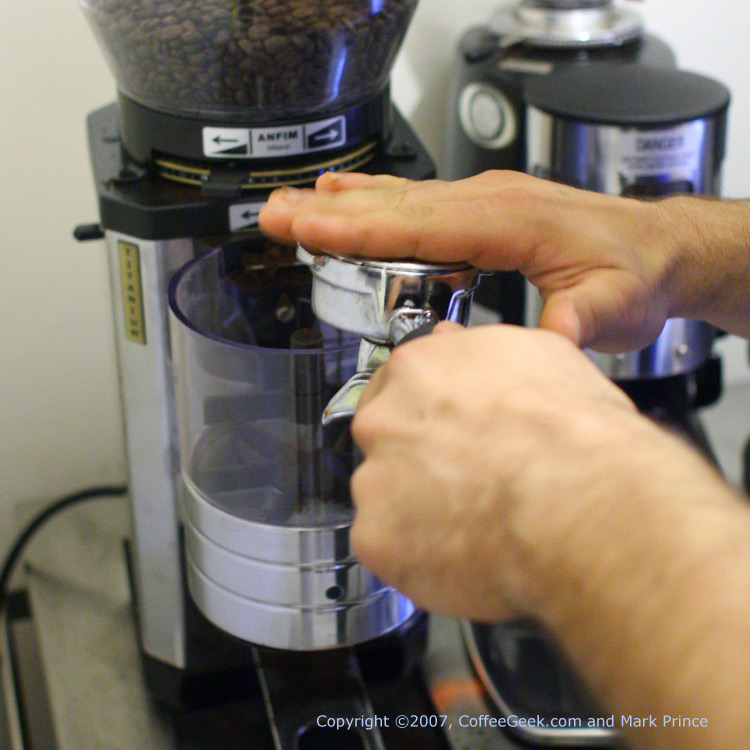
Because of this, the skill of the barista behind the machine is paramount to doing a good and fair evaluation of an espresso blend. Italy’s famous Four “M” rule (machine, grinder, blend and person, all equally important to the process) is very much in play here. The skillset of the barista is so important that, in my humble opinion, I believe only world-seasoned baristas, and especially baristas with experience on a wide range of machines, with a wide range of coffees should be utilised when a “professional” espresso rating and ranking is taking place (and no, I don’t consider myself in that league, which is why I got others to pull the shots in our Italy vs. N. America espresso shootout). This means that those rockstar, portafilter-twirling superstars, brilliantly awesome in their own environment working on the same blend day in and day out may not be the best candidates for doing a wide ranging evaluation.
Those with a wide ranging experience usually have the ability to find any coffee blends’ sweet spot if it exists. They have enough experience to do a visual, olfactory, and taste evaluation on the first shot or two to be able to diagnose and correct problems with a wide array of tools at their hand, be it dose, grind, tamp, machine temperature, pack, levelling and distribution procedure, you name it.
Because of all of this, not only is having a well experienced barista pulling shots paramount to doing the fairest possible evaluation of an espresso blend, but I believe the barista should have a say in the overall score of the blend. After all, they’re tasting more of the blend than any of the separate tasters. They’re finding out how easy or difficult the blend is to work with. They’re finding more taste notes and nuances in the shot, both good and bad than anyone else in the room is.
The coffee blends
If you didn’t already guess by now, I decided to evaluate some popular and high end North American espresso blends against some equally popular and well regarded Italian roasted blends. Initially I was going to mirror Ken’s test – put Intelligentsia, Starbucks and Peets against his choices on the Italian side. As I mentioned in my previous State of Coffee article, I changed the choices, and for some very good reasons.
Out of all the Italian-roasted coffees that Ken reviewed, there’s one commonality amongst them: age of beans. These coffees are typically ocean-shipped in big containers to save on freight cost, and stored in the distributors’ warehouses before eventually making it out to regional distributors and to the store shelves. We’re talking weeks and weeks after roasted, and more likely months and months after the roasting date. It’s interesting to note that none of the coffees, save for Intelligentsia and Peets (for mail order), put roast-dates on the bags or tins. The majority of the coffees in the Coffee Review evaluation have “best by” dates – some of them a year or more into the future.
I said it before and I can’t emphasise this enough: Quality espresso requires fresh roasted coffee. The espresso preparation method exposes more damage in the cup from stale beans than any other brewing method does. I could go into a ton of detail on this, and I probably will in a future article, but for now – fresh roasted = better espresso.
Researching the Blends
With the list of coffees Davids chose to evaluate fresh in hand, I fired off some detailed emails to friends in Italy, some who are top flight baristas, some who are industry luminaries for quality-driven espresso machine manufacturers. While I was waiting for their responses, I went to some local Italian experts on good food and coffee. All were told Davids’ choices and scores, and all were asked if these were good choices. Some of the blends reviewed on Coffee Review got some nice “ha ha ha”s in the email back – I was told that some of these coffees do not represent the best that Italy has to offer in great espresso blends.
Then I was given recommendations – most of which I couldn’t obtain in Canada – blends that are from tiny micro roasters, doing their own unique thing, and (in most cases) roasting for their own cafes. But some of the recommendations I could go with. Here’s the list of blends I ended up choosing for both sides of the Battle:
Battle Italy
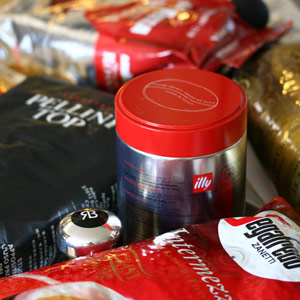
Pellini Caffe “Top”, (website). This is a 100% arabica blend, and the top pick for three out of the five experts I polled in Italy. I was fortunate to find it in a local store, so I bought the 1kilo bag.
Pellini Caffe “Aroma Oro”. Also heavily recommended as a good arabica / robusta blend.
Segafredo “Intermezzo”, (website). Picked because it is one of the most popular coffees in N. Italy, for both price and “quality”.
Segafredo “Metropol”, (website). Considered Segafredo’s premium blend, and supposedly better than the Massimo. It’s an arabica / robusta blend.
Illy “Medium Roast” (red can) and “Dark Roast” (black can) (website). One can each – how can you not include Illy’s offerings in this test? But we ended up not doing the dark roast because I could not find a can of whole bean in time for the test (I did find plenty of preground).
Lavazza “Qualita Oro”, (website). This was recommended by two of the five Italians I polled, and is considered the company’s top 100% arabica blend available for retail sale (a commercial blend called Pienaroma is supposedly their best, but it’s commercial only, not consumer-retail).
Lavazza “Qualita Rossa”. This blend is considered their best arabica / robusta blend (and much better than the robusta-laden “super crema” blend that Davids tested on Coffee Review).
Battle North America
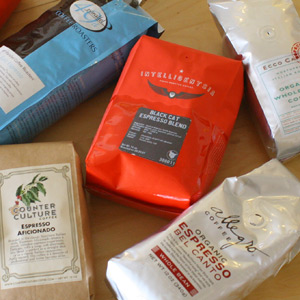
On the N. American side of things, I decided to use a few famous blends, as well as a few that maybe you haven’t heard of, but ones that have tasted pretty good to me in the past:
Intelligentsia Black Cat, (website). Tested in Ken Davids’ review of these coffees, and not what I’d consider a “Northern Italian” style roast these days.
49th Parallel Epic Espresso, (website). One of my favourite new blends these days, and roasted very uniquely to each component in the blend.
Ecco Caffe, Ecco Reserve and Ecco Organic Blends (website). Two blends from Ecco Caffe. I hadn’t had Andrew Barnett’s master blend in a long time (Ecco Reserve) which is a complete homage to the Northern Italian style, and since I wanted a few organics in the test, I picked his offering in this category as well.
Counter Culture Coffee, Espresso Aficionado Blend, (website). One of the more obscure blends from Counter Culture, and priced at only $10 per 12oz bag, this is their Northern Italian style roast blend.
Allegro Coffee’s Organic Bel Canto Blend (website). This is Allegro’s organic, Northern Italian style espresso blend, and from a company we don’t talk much about on CoffeeGeek, something I aimed to change with this article
Ritual Coffee Roaster’s Red Flag Espresso (website). Another roaster that many insiders know about, but not many in the general know of – unfortunately, their coffee didn’t arrive in time for the testing.
There’s many other roasters I could have included, but I wanted to limit the battle to seven vs. seven (ended up being seven vs. six). I certainly recommend that you give a try to roasters like Batdorf and Bronson, Terroir Coffee, Paradise Roasters, PT’s Coffees, and others, and I wish I could have included them all, and others in the test. But we work with what we work with.
A New Testing and Ranking Method for Espresso
So what’s the methodology we should follow to properly and fairly evaluate espresso? That was the bulk of the discussions I had in the waning weeks of August. Some of the contributors included Vince Piccolo – who I consider to be one of the best, most rounded baristas in the world – and the brothers Colter and Barrett Jones – Colter was Canada’s 2007 representative at the World Barista Championship, and Barrett took second in Canada in 2006. Both were fresh from the 2007 WBC in Japan, and had still-fresh memories of all the stellar espressos they tried over there.
I also had talks with Andrew Barnett, of Ecco Caffe, Doug Zell of Intelligentsia Coffee (last year’s WBC Chairperson) and Jeff Taylor of PT’s Coffee, (a long time WBC judge) just to name a few of many. A lot of what is coming up in the next article is the result of a lot of consensus in these discussions, which is a great thing. The resulting methods are by no means perfect, but I think it is a pretty good starting point to doing proper espresso evaluation and preparation.
The article, along with our evaluation results, will be up in a few days – after all, I have to give you a bit of time to digest and discuss all that’s been said in this part one. But as a sneak peak, we had one simple rule as tasters in this evaluation: no point score is sacred or out of bounds. That means that if one element deserves a 2, a 1, or even a 0, it would get that score… no “5” bottom lines. Same holds true for the proverbial 10. If crema was the best we’d ever seen in our entire espresso-drinking lives, it would get a 10 on the score sheet, no problem.
We broke the points system down into our own 100 point scale with the following breakdown: Sweetness – 10 points; Body – 10 points; Aftertaste – 10 points; Acidity – 10 points; Crema – 10 points; Aroma – 10 points; “With Milk” (cappuccino) – 10 points; Judges’ overall score – 10 points. These 80 points may look quite familiar to those who have used a cupping score sheet, but there’s a caveat here – we had written rules on how to interpret these things, and some of them are very different from the cupping-method evaluation – especially things like acidity and aroma.
Most importantly, we included the Barista’s score – 20 points. No, that’s not scoring the barista on their technique. That’s the barista themselves deciding how much, out of 20, the coffee should get, based on
- how easy the blend is to dial in
- how “forgiving” the espresso blend is at different temperatures / brewing conditions
- range of flavours experienced in the cup during dial in
- quality of the shot pour as it happens
- taste in the best shot produced out of a given sample (our sample rate was 2lbs, or 1kilo, per blend)
I want to be particularly clear on this – this is one of the misconceptions Ken had in his rebuttal to my previous article, when he said:
“Mark indirectly accuses me of being too engaged in the protocols of cupping to make a proper judge of espresso. What I think he is implying here is that espresso should only be judged in the full context of the visual and performance aspects of its production. In other words, it appears that from Mark’s point of view that the crema, the pour, and (in the case of barista contests) the entire magnificent theater of drink production should be taken into account when evaluating espresso.”
No. As stated above, the barista’s judgement on the espresso is just as important as the tasting judges… if not more so. It has nothing to do with theatrics – it has to do with taste, ease of use of the blend, and everything in between.
In the next article (which is now online) I’ll break this all down for you, and have the test results, which will surprise some, but also confirm the thoughts others may have had when they read the evaluation in August on Coffee Review. Until then, I do invite your comments and suggestions on everything discussed – you can do so by clicking the comments read | write below or at the top of the article (nb: you must be logged in to see this feature).



